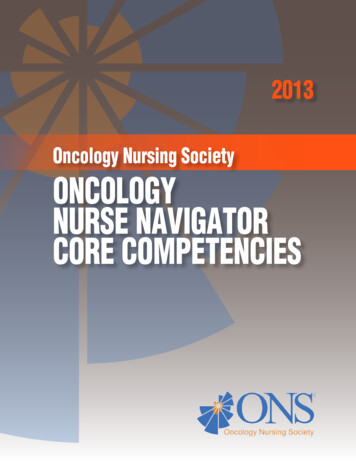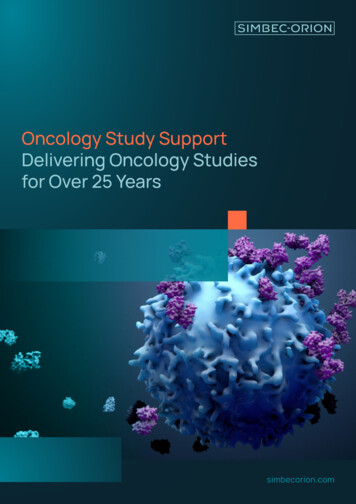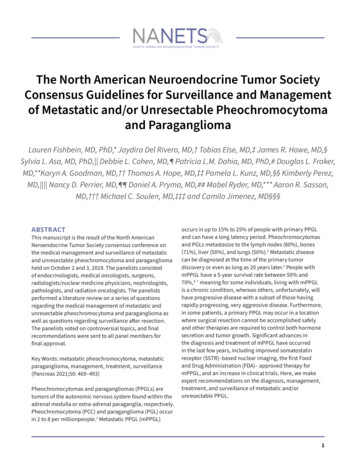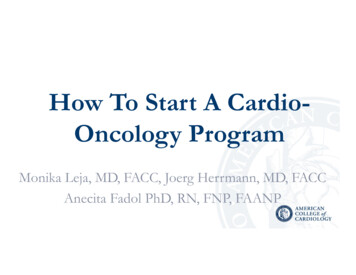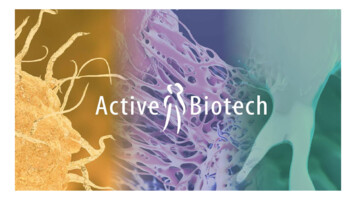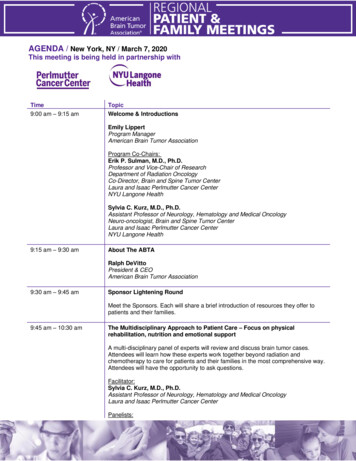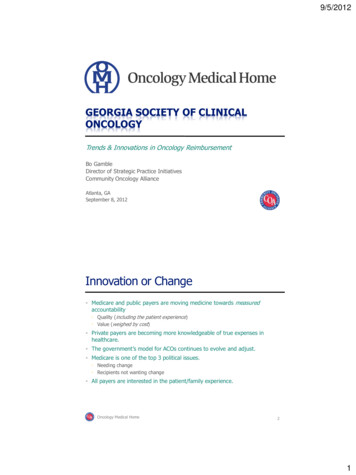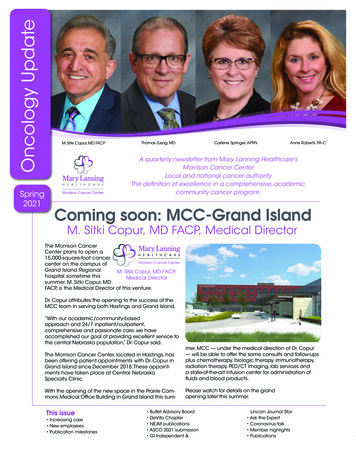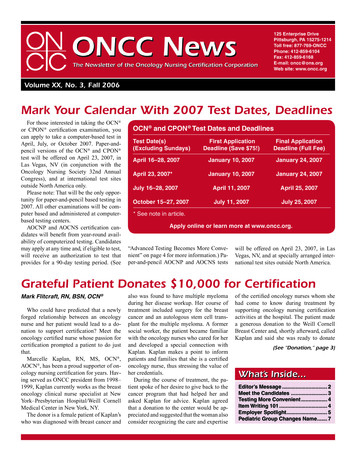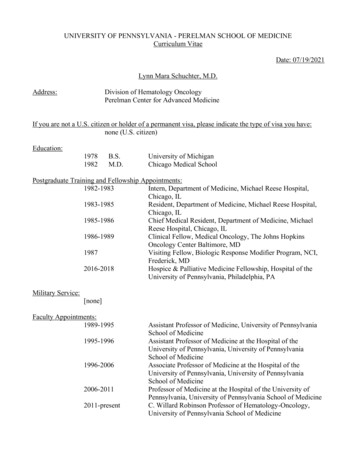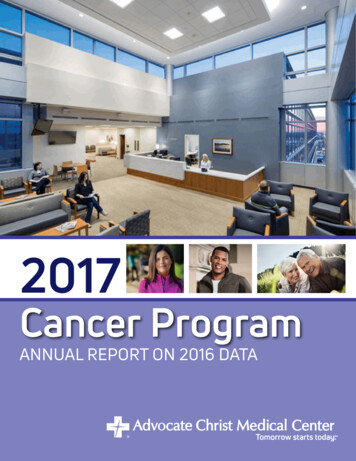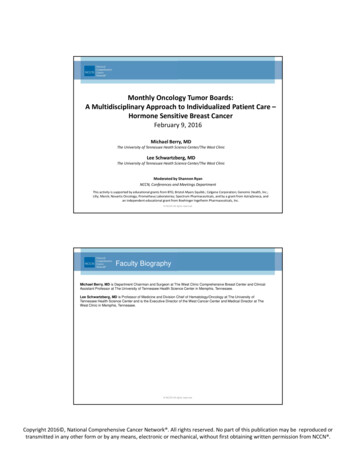
Transcription
Monthly Oncology Tumor Boards:A Multidisciplinary Approach to Individualized Patient Care –Hormone Sensitive Breast CancerFebruary 9, 2016Michael Berry, MDThe University of Tennessee Heath Science Center/The West ClinicLee Schwartzberg, MDThe University of Tennessee Heath Science Center/The West ClinicModerated by Shannon RyanNCCN, Conferences and Meetings DepartmentThis activity is supported by educational grants from BTG; Bristol‐Myers Squibb.; Celgene Corporation; Genomic Health, Inc.;Lilly; Merck; Novartis Oncology; Prometheus Laboratories; Spectrum Pharmaceuticals, and by a grant from AstraZeneca, andan independent educational grant from Boehinger Ingelheim Pharmaceuticals, Inc. NCCN All rights reserved.Faculty BiographyMichael Berry, MD is Department Chairman and Surgeon at The West Clinic Comprehensive Breast Center and ClinicalAssistant Professor at The University of Tennessee Health Science Center in Memphis, Tennessee.Lee Schwartzberg, MD is Professor of Medicine and Division Chief of Hematology/Oncology at The University ofTennessee Health Science Center and is the Executive Director of the West Cancer Center and Medical Director at TheWest Clinic in Memphis, Tennessee. NCCN All rights reserved.Copyright 2016 , National Comprehensive Cancer Network . All rights reserved. No part of this publication may be reproduced ortransmitted in any other form or by any means, electronic or mechanical, without first obtaining written permission from NCCN .
Case # 1 34 yo premenopausal white female noticed a lump inher left breast while camping. Lump is hard, nonmobileand nonpainful. Saw NP and had US with shadowing at 1 oclock. Seenby general surgeon and biopsy done Biopsy: grade 2 infiltrating ductal cancer, ER 90%, PR 90%, HER2 2 by IHC, FISH pending PMHx: Hypothyroidism, Hypertension, Gestationaldiabetes; Cholecystectomy Gyn Hx; G4P2, 18 weeks pregnant on OCP Social Hx: Nurse, Married, 12 pack‐year smoking hx,none in 5 yearsCase # 1 Physical exam: 4.5 x 3.5 mobile mass at 2o’clock. No lymphadenopathy ECHO EF 60‐65% Genetic testing: Multigene panel negative Patient wishes breast conservation FISH for HER2 amplificationCopyright 2016 , National Comprehensive Cancer Network . All rights reserved. No part of this publication may be reproduced ortransmitted in any other form or by any means, electronic or mechanical, without first obtaining written permission from NCCN .
Surgery in Pregnant Women Modern anesthetic agents very safe in thesetting of pregnancy General concerns regarding anesthesia onpregnant patient– 1st trimester ‐ organogenesis– 2nd trimester ‐ safest time to operate– 3rd trimester‐ premature laborCopyright 2016 , National Comprehensive Cancer Network . All rights reserved. No part of this publication may be reproduced ortransmitted in any other form or by any means, electronic or mechanical, without first obtaining written permission from NCCN .
SLN Biopsy in Pregnant Women 25 cN0 patients had SNBx when pregnant– 8 (1st trim.), 9 (2nd trim.) and 8 (3rd trim.)– 16 TC‐99 alone, 7 meth. blue alone and 2 ? method– Isosulfan blue does not have FDA clearance forpregnancy– 24/25 live born infants without complications, 1/25 withcleft palate (maternal risk factors)– SLN biopsy accurate and safe in pregnant pop.Gropper AB,Ann Surg Oncol. Aug;21(8):2506‐11Breast Cancer in Pregnancy A fairly rare event, but increasing as age ofpregnancy gets later (up to 36/100,000) Historically was considered to convey a poorprognosis in era before modern adjuvant rx Generally higher grade and advanced stage atdiagnosis No randomized trialsCopyright 2016 , National Comprehensive Cancer Network . All rights reserved. No part of this publication may be reproduced ortransmitted in any other form or by any means, electronic or mechanical, without first obtaining written permission from NCCN .
Breast Cancer in Pregnancy:Recent studies Litton J, et al 2013 Single institution(MDACC) case controlstudy Prospective registry N 75 affected Published with 16 yr f/u2013 Amant F, et. al 2013 Multinational Europeanregistry Prospective andretroactive 2003‐2011Clinical Pathologic Variables:European registryPregnant patients:Higher grade,Higher stage,Less ER , more TNCopyright 2016 , National Comprehensive Cancer Network . All rights reserved. No part of this publication may be reproduced ortransmitted in any other form or by any means, electronic or mechanical, without first obtaining written permission from NCCN .
Registry resultsDFS: HR Pregnancy 1.34 (0.93‐1.91, p .14)OS: HR Pregnancy 1.19 (0.73‐1.93, p .51)Amant F, et. al JCO 2013A: DFS, B: OSSingle Institution Cohort StudyPregnancy ptsDid better!Litton J, Oncologist 2013Copyright 2016 , National Comprehensive Cancer Network . All rights reserved. No part of this publication may be reproduced ortransmitted in any other form or by any means, electronic or mechanical, without first obtaining written permission from NCCN .
Chemotherapy during pregnancy Anthracyclines, cyclophosphamide (5 FU) safeduring 2nd and 3rd trimester Taxanes not sufficiently studied Trastuzumab contraindicated– Oligohydramnios– Fetal effectsCopyright 2016 , National Comprehensive Cancer Network . All rights reserved. No part of this publication may be reproduced ortransmitted in any other form or by any means, electronic or mechanical, without first obtaining written permission from NCCN .
Case #1 Completing AC chemotherapy, every 3 weeks x4 Clinically responding to therapy with goodpartial response to AC Plan for adjuvant paclitaxel/trastuzumabfollowed by a year of trastuzumab aftersurgeryCopyright 2016 , National Comprehensive Cancer Network . All rights reserved. No part of this publication may be reproduced ortransmitted in any other form or by any means, electronic or mechanical, without first obtaining written permission from NCCN .
What is the optimal adjuvantendocrine therapy in this patient?Copyright 2016 , National Comprehensive Cancer Network . All rights reserved. No part of this publication may be reproduced ortransmitted in any other form or by any means, electronic or mechanical, without first obtaining written permission from NCCN .
Endocrine Therapy:Tamoxifen or OFS/AI?SOFT Trial: Efficacy Outcomes for OFS Exemestane vs Tamoxifen Alone5-YrOutcome,%OFS ExemestaneTamoxifenAloneRiskReductionP ValueDFS89.084.732 .05DDFS93.090.729 .05FBC90.986.436 .05OS95.395.13NSFrancis PA, et al. N Engl J Med. 2015;372:436-446.Dual Therapy in SOFT: 5‐Yr Breast Cancer–FreeInterval With and Without ChemotherapyRegimen, %No ativeImprovement22.0Women 35 Yrs of Age(94% Received Chemo)5‐Yr BreastCancerIncidenceRelativeImprovementTam4.2OFS Tam4.9517.52232.321.1‐‐‐OFS AI2.94114.33516.6‐‐‐ Higher‐risk pts received chemotherapy and benefited from itsaddition to OFS Pts who did not receive chemotherapy had such a low baseline riskthat efficacy is difficult to assessFrancis PA, et al. N Engl J Med. 2015;372:436-446.Copyright 2016 , National Comprehensive Cancer Network . All rights reserved. No part of this publication may be reproduced ortransmitted in any other form or by any means, electronic or mechanical, without first obtaining written permission from NCCN .
Case #2 60 y/o obese WFMenarche 16 y/o, G4 P4, menopause 45 y/oBCP X 3yrs, no HRTPMHx: bipolar, hypothyroidismFHx: neg.Case #2 PE: RB, 10:00, 2.3 X 2.0cm mobile mass, cN0 Mam: RB, 10:00, 2.6 X 1.8 ill‐defined stellatemass (BIRADS 4) Sono: RB, 10:00, 2.4 X 2.0 X 1.6 ill‐definedhypo echoic irregularly shaped mass withposterior shadowing (BIRADS 4) Core biopsiedCopyright 2016 , National Comprehensive Cancer Network . All rights reserved. No part of this publication may be reproduced ortransmitted in any other form or by any means, electronic or mechanical, without first obtaining written permission from NCCN .
Case #2 Path: IDC, Gr 1 , ER 100%, PR 100%,Her‐2 neg. (IHC), Ki‐67 10% cStage IIA (cT2 cN0 cM0) Large breast amenable to breast conservingsurgery which pt. desiredMargins in Breast Conserving Therapy forInfiltrating Carcinoma SSO and ASTRO Consensus Guidelines formargins in Stage I & II cancer patientsundergoing breast conserving surgery andWBI (2014) Meta‐analysis on 28,000 pts. with min.median follow up of 4 years in studies from1965‐2013 No neo‐adj. or pure DCIS in these guidelines-J Clin Oncol. 2014 May 10;32(14):1507‐15Copyright 2016 , National Comprehensive Cancer Network . All rights reserved. No part of this publication may be reproduced ortransmitted in any other form or by any means, electronic or mechanical, without first obtaining written permission from NCCN .
Importance of Margins in BreastConserving Therapy Pos. margin ink on tumor (inv. or DCIS) at edge ofresected tissue in breast conserving surgery– 2 fold increase in IBTR (regardless of XRT boost,ca. biology or systemic therapy) Neg. margin NO ink on tumor at edge of resectedtissue– Lowest risk of IBTR– Increase width doesn’t lower riskJ Clin Oncol. 2014 May 10;32(14):1507‐15Importance of Margins in BreastConserving Therapy Systemic therapy lowers IBTR– If not received, there is no evidence that widermargins add benefit compared with negativemargins Women 40 y/o have increased IBTRregardless of width of negative margin EIC has no increased risk of IBTR if neg.marginsJ Clin Oncol. 2014 May 10;32(14):1507‐15Copyright 2016 , National Comprehensive Cancer Network . All rights reserved. No part of this publication may be reproduced ortransmitted in any other form or by any means, electronic or mechanical, without first obtaining written permission from NCCN .
Copyright 2016 , National Comprehensive Cancer Network . All rights reserved. No part of this publication may be reproduced ortransmitted in any other form or by any means, electronic or mechanical, without first obtaining written permission from NCCN .
ACOSOG Z0011Clinically Negative Patients1-2 Positive SNs by H & ELumpectomy Breast XRTTarget Accrual:1900 women (500deaths)Actual Accrual:891 pts(94 deaths)RandomizationCompletion AxillaryNode Dissection(n 445)No FurtherSurgery(n 446)N 436N 420Included in Primary AnalysisGiuliano AE, et al. JAMA. 2011;305(6):569-575.ACOSOG Z0011ResultsSNBCompletionPAloneANDvalueAdditional Positive Nodeson ANDN/A27.3%?5-Year In-BreastRecurrence2.1%97 pts3.7%0.165-Year Axillary NodalRecurrence1.3%0.6%0.445-Year Overall Survival92.5%91.8%HR: 0.87(90-95.1)83.9%(89.1-94.5)82.2%.25HR: 0.88(80.2-87.9)(78.3-86.3).14Endpoint5-Year DFSGiuliano AE, et al. JAMA. 2011;305(6):569-575.Copyright 2016 , National Comprehensive Cancer Network . All rights reserved. No part of this publication may be reproduced ortransmitted in any other form or by any means, electronic or mechanical, without first obtaining written permission from NCCN .
ACOSOG Z0011: Conclusions T1‐2, cN0 BC pts undergoing lumpectomyand XRT– cN0 non‐palpable If 1‐2 SLN for macromets., no ALND oradditional radiation fields needed No difference in L/R recur, DFS or OS in ALNDvs No ALND group (6.3 yr F/U)Giuliano AE, et al. JAMA. 2011;305(6):569-575.Recommendations for SLN SLN‐, don’t do ALND SLN (micromets), don’t do ALND whetherlumpectomy or mastectomy– Don’t do routine IHC to find micromets SLN (macromets), don’t do ALND if only 1‐2 nodes, having lumpectomy and receivingWBI and systemic tx– 2/3 of all node pts. have only 1‐2 nodes pos.Copyright 2016 , National Comprehensive Cancer Network . All rights reserved. No part of this publication may be reproduced ortransmitted in any other form or by any means, electronic or mechanical, without first obtaining written permission from NCCN .
When is ALND required ? cN posIBC 2 SLN (macromet)Gross extra‐nodal tumor extensionResid. palp nodes after SLN bxSLN (macromet) having mastectomySLN (macromet) not receiving XRT orsystemic txCase #2 Surgery: partial mastectomy with SLN bx converted to ALND.Several (4) nodes clinically pos. during surgery led toconversion Path:– Breast: IDC 3.2cm, biology unchanged, LVI ,EIC , closestmargins 2mm for IDC and 1mm for DCIS others widely clear– LN: 5/11 pos. nodes, largest 1.8cm with extra‐nodalextension– pStage IIIA (pT2 pN2 M0)Copyright 2016 , National Comprehensive Cancer Network . All rights reserved. No part of this publication may be reproduced ortransmitted in any other form or by any means, electronic or mechanical, without first obtaining written permission from NCCN .
Mean904 NodeNegative0109‐Years Risk of Distant Recurrence (%)100Results: For Any Recurrence Score the Rate of DistantRecurrence Increases with the Number of Positive Nodes05101520253035404550Recurrence ScoreDowsett et al., SABCS 2008, Abstract # 53Copyright 2016 , National Comprehensive Cancer Network . All rights reserved. No part of this publication may be reproduced ortransmitted in any other form or by any means, electronic or mechanical, without first obtaining written permission from NCCN .
Does chemotherapy help all node positive patients?Biology may play a larger role than anatomyDISEASE‐FREE SURVIVAL BY TREATMENTRS 31RS 18‐30RS 181.000.750.50Stratified log‐rankP 0.97 at 10 yearsHR 1.02 (0.54‐1.93)0.25Stratified log‐rankP 0.033 at 10 yearsHR 0.59 (0.35‐1.01)Stratified log‐rankP 0.48 at 10 yearsHR 0.72 (0.39‐1.31)CAF T (n 91, 26 events)Tamoxifen (n 55, 15 events)CAF T (n 46, 22 events)Tamoxifen (n 57, 20 events)CAF T (n 47, 26 events)Tamoxifen (n 71, 28 events)0.000246810 0Years Since Registration246Years Since Registration810 0246810Years Since RegistrationAlbain KS, et al. Lancet Oncol. 2010;11(1):55‐65.48Copyright 2016 , National Comprehensive Cancer Network . All rights reserved. No part of this publication may be reproduced ortransmitted in any other form or by any means, electronic or mechanical, without first obtaining written permission from NCCN .
Case # 3 79 yo WF presented in 2009 with breast mass Core biopsy showed ILC with ductal component,grade 2 ER PR Her2‐. Palpable axillary LN Underwent bilat mastectomies:– Left 7.4 cm infiltrating ductal cancer with associatedcomedo DCIS 13/19 LNs positive– Right, 2 cm intracystic papillary cancer with negativemargins, 6 LNs negative– PET/CT scan internal mammary nodes Intracystic Papillary Carcinoma (IPC) 1% of breast cancers Pure form or associated with IDC or DCIS Dx: Micro: IHC for intact myoepithelial celllayerYA Bndkaddour, et al Obstet Gynecol. 2012; 2012:979563Copyright 2016 , National Comprehensive Cancer Network . All rights reserved. No part of this publication may be reproduced ortransmitted in any other form or by any means, electronic or mechanical, without first obtaining written permission from NCCN .
Intracystic Papillary Carcinoma (IPC) Treatment:– Pure form: surgical resection alone, no data tosupport any additional therapy– Associated with IDC or DCIS: target adjuvant XRT orendocrine based on this component Prognosis:– Pure form: Excellent with exc. alone– Associated IDC or DCIS: determines prognosisYA Bndkaddour, et al Obstet Gynecol. 2012; 2012:979563Case #3Adjuvant TC X 6RT to chest wall, SCLNs and IM LNsBegan letrozole 10/09Tolerated it well with good adherence11/15 presented with mild‐mod pain in lowerback x 2 months, not precipitated by trauma ormovement, slowly worse Obtained laboratory showed increase tumormarker Copyright 2016 , National Comprehensive Cancer Network . All rights reserved. No part of this publication may be reproduced ortransmitted in any other form or by any means, electronic or mechanical, without first obtaining written permission from NCCN .
Case #3 Bone scan: Extensive osseous disease incalvarium, multiple levels thoracic and lumbarspine, most pronounced in L1, pelvic, L distalhumerus CT CAP: No definite disease, questionablelesion L1, no vertebral compression CA15‐3 974; CEA 99What 1st line therapy should thepatient begin?Copyright 2016 , National Comprehensive Cancer Network . All rights reserved. No part of this publication may be reproduced ortransmitted in any other form or by any means, electronic or mechanical, without first obtaining written permission from NCCN .
Double blind Phase 3Primary endpoint: PFSCopyright 2016 , National Comprehensive Cancer Network . All rights reserved. No part of this publication may be reproduced ortransmitted in any other form or by any means, electronic or mechanical, without first obtaining written permission from NCCN .
PALOMA‐3:Efficacy and safetyTurner NC, et. al. NEJM 2015Case #3 Letrozole D/CBegan Fulvestrant/Palbociclib 12/15Also began denosumabGood tolerance; mild neutropeniaInitial tumor markers at 6 weeks were CA15‐3686, CEA 65Copyright 2016 , National Comprehensive Cancer Network . All rights reserved. No part of this publication may be reproduced ortransmitted in any other form or by any means, electronic or mechanical, without first obtaining written permission from NCCN .
Three Identical International, Randomized, Double‐Blind, Active‐Controlled TrialsEnrollment Criteria Adults with breast, prostate,or other solid tumors andbone metastases ormultiple myelomaDenosumab 120 mg SC andPlacebo IV* every 4 weeks (N 2862)Supplemental Calcium and Vitamin D Recommended No current or prior IVbisphosphonateadministration for treatmentof bone metastasesZoledronic Acid 4 mg IV* andPlacebo SC every 4 weeks (N 2861)1 Endpoint Time to first on-study SRE (non-inferiority)2 Endpoints Time to first on-study SRE (superiority) Time to first and subsequent on-study SRE (superiority)Primary Endpoint: Time to First On-Study SREProportion of Subjects Without SREBreast Cancer (N 2046) 1Prostate Cancer (N 1901) 2Other Solid Tumors orMultiple Myeloma (N 1776) 3DenosumabZoledronic acid1.00.80.60.40.20.0HR 0.82 (95% CI: 0.71, 0.95)P .0001 (Non-inferiority)P 0.01 (Superiority)06121824HR 0.82 (95% CI: 0.71, 0.95)P 0.0002 (Non-inferiority)P 0.008 (Superiority)3006121824HR 0.84 (95% CI: : 0.71, 0.98 )P 0.0007 (Non-inferiority)P 0.06 (Superiority)300612182430Study Month* All data come from the primary analysis phase of these studies1Stopeck A et al. Eur J Cancer Suppl. 2009;7:2(Abs 2LBA); 2Fizazi K, et al. J Clin Oncol. 2010; 28:18s, (Abs LBA4507); 3Henry D,et al. Eur J Cancer Suppl. 2009;7:11(Abs 20LBA)Copyright 2016 , National Comprehensive Cancer Network . All rights reserved. No part of this publication may be reproduced ortransmitted in any other form or by any means, electronic or mechanical, without first obtaining written permission from NCCN .
Incremental Benefits in Breast Cancer64% risk of skeletal complication with no bisphosphonate at 2 yrsApprox 33% risk reduction with pamidronateFurther 20% risk reduction with zoledronic acidAdditional 18% riskreduction withdenosumab64%43%34%27%Lipton A, et al. Cancer. 2000;88:3033-3037. Rosen LS, et al. Cancer. 2003;100:36-43. Stopeck A, et al.JCO 2010;28:5127-31.Copyright 2016 , National Comprehensive Cancer Network . All rights reserved. No part of this publication may be reproduced ortransmitted in any other form or by any means, electronic or mechanical, without first obtaining written permission from NCCN .
NCCN Member InstitutionsCopyright 2016 , National Comprehensive Cancer Network . All rights reserved. No part of this publication may be reproduced ortransmitted in any other form or by any means, electronic or mechanical, without first obtaining written permission from NCCN .
Regimen, %No Chemotherapy Chemotherapy Women 35 Yrs of Age (94% Received Chemo) 5‐Yr Breast Cancer Incidence Relative Improvement 5‐Yr Breast Cancer Incidence Relative Improvement 5‐Yr Breast Cancer Incidence Relative Improvement Tam 4.2 22.0 32.3 OFS Tam 4.9 5 17.5 22 21.1 ‐‐‐ OFS AI 2.9 41 14.3 35 16.6 ‐‐‐
